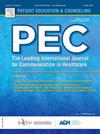Mobile app-based pain management education for ambulatory surgery patients in Denmark: A Legitimation Code Theory analysis
IF 3.1
2区 医学
Q2 PUBLIC, ENVIRONMENTAL & OCCUPATIONAL HEALTH
引用次数: 0
Abstract
Objectives
This paper analyzes the educational content of the MinSmerte (MyPain) app, designed to educate patients on postoperative pain management after ambulatory surgery. It examines the complexity of instructional videos, investigating how these relate to the legitimacy claims constructed by educators – defined as assertions about the value of the information based on its relevance, authority, alignment with community norms. Patient feedback is explored to assess their perceptions of the app’s effectiveness in facilitating knowledge building.
Methods
The study involved an analysis of three instructional videos using the Semantics dimension of Legitimation Code Theory. Additionally, the Specialization dimension was used to analyse data from telephone interviews with 29 post-discharge patients, focusing on their perceptions of the app’s accessibility, comprehensibility, and usability, in relation to their everyday pain management practices. Interviews included specific questions to evaluate patients’ health literacy levels and how those influenced their perception of accessibility, comprehensibility, and usability.
Results
The instructional videos employed accessible language but varied in effectiveness. Some patients found the app beneficial for connecting with the hospital and tracking progress, while others faced challenges in navigation and clarity.
Conclusion
Mobile apps for patient education hold significant potential for postoperative pain management. The study highlights the importance of customizing both content and technical aspects of the app to align with patients’ health literacy and their perceptions of accessibility, comprehensibility, and usability for optimizing the educational impact.
Practice implications
Findings stress the importance of assessing health literacy in patient education apps to enhance patient experiences and promote knowledge building through a framework of socially just pedagogies. Legitimation Code Theory provides a valuable framework for understanding knowledge dynamics in app-based education, emphasizing the importance of patient involvement in the co-design process.
基于移动应用程序的丹麦门诊手术患者疼痛管理教育:合法性代码理论分析
目的分析MinSmerte (MyPain)应用程序的教学内容,旨在对患者进行门诊手术后疼痛管理的教育。它考察了教学视频的复杂性,调查了这些与教育者构建的合法性主张之间的关系-定义为基于其相关性,权威性,与社区规范一致的信息价值的断言。研究了患者的反馈,以评估他们对应用程序在促进知识建设方面的有效性的看法。方法运用正当性符码理论的语义维度对三部教学视频进行分析。此外,专业化维度用于分析来自29名出院后患者的电话访谈数据,重点关注他们对应用程序的可访问性、可理解性和可用性的看法,以及与他们日常疼痛管理实践的关系。访谈包括评估患者健康素养水平的具体问题,以及这些问题如何影响他们对可及性、可理解性和可用性的看法。结果教学视频采用无障碍语言,但效果差异较大。一些患者发现该应用程序有助于与医院联系并跟踪进展,而另一些患者则在导航和清晰度方面面临挑战。结论移动教育应用程序在术后疼痛管理中具有重要的应用潜力。该研究强调了定制应用程序的内容和技术方面的重要性,以配合患者的健康素养以及他们对可访问性、可理解性和可用性的看法,以优化教育影响。实践意义研究结果强调了在患者教育应用程序中评估健康素养的重要性,通过社会公正的教学法框架来增强患者体验和促进知识建设。合法化代码理论为理解基于应用程序的教育中的知识动态提供了一个有价值的框架,强调了患者参与协同设计过程的重要性。
本文章由计算机程序翻译,如有差异,请以英文原文为准。
求助全文
约1分钟内获得全文
求助全文
来源期刊

Patient Education and Counseling
医学-公共卫生、环境卫生与职业卫生
CiteScore
5.60
自引率
11.40%
发文量
384
审稿时长
46 days
期刊介绍:
Patient Education and Counseling is an interdisciplinary, international journal for patient education and health promotion researchers, managers and clinicians. The journal seeks to explore and elucidate the educational, counseling and communication models in health care. Its aim is to provide a forum for fundamental as well as applied research, and to promote the study of organizational issues involved with the delivery of patient education, counseling, health promotion services and training models in improving communication between providers and patients.
 求助内容:
求助内容: 应助结果提醒方式:
应助结果提醒方式:


